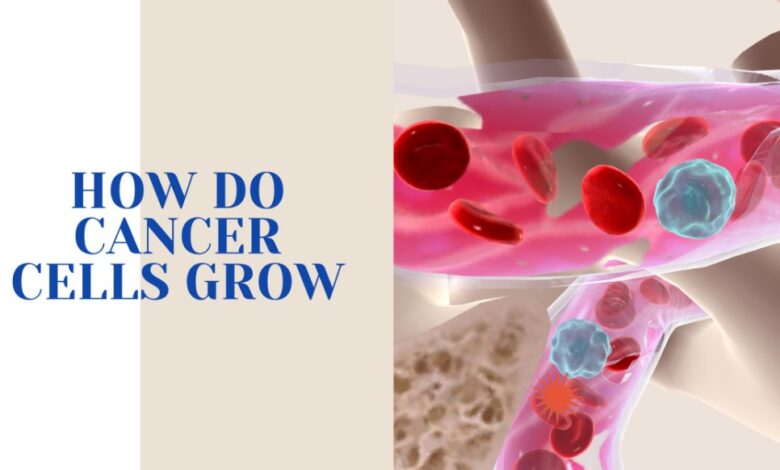How do cancer cells grow and what are the signs?

When the erroneous cells grow excessively and have the ability to invade and destroy healthy bodily tissues, they are called cancer. There are many other diseases that share this characteristic. This is so because the most significant cancers spread and grow all over the body. Actually, cancer is one of the main causes of death in the world. Still, due to advancement in the matters of detection and treatment and even early identification, most types of cancers have good survival rates. In the medical field, it is important to be highly conversant about cancer particularly when relating with patients. Due to the burden of work and internships, many medical students turn to services like online assignment help because they feel that it is more important to learn something about cancer disease and its prevention than to waste time making assignments. To do this challenging profession and handle their burden, people seek online help.
The first sign that manifested in the human system was wildly growing cells, which is a general term describing a vast range of disorders. Such altered cells may move to different parts of the body by invasion into the tissue. There are more than a hundred distinct forms of cancer, and each has its own traits, danger signs, and signs.
What are the different types of cancer cell?
The variety of cancer types is equal to the variety of cancer cell types. Most of the more than 100 different forms of cancer are called after the kind of tumor cells that first gave rise to the illness.
Cancer patients frequently need ongoing care and assistance. The complicated requirements faced by these patients must be understood by a large number of nursing students. But juggling coursework and hospital obligations can be taxing, which is why many turn to services like “pay someone to take my online nursing class“ in an attempt to decompress from their burden.
Carcinomas
Cancers known as carcinomas develop in the cells known as epithelial lining bodily cavities. Carcinomas, the most prevalent form of cancer cells, are called after the kind of cell membrane that underwent the mutation.
Sarcomas
Sarcomas are cancers caused by cells known as mesenchymal cells. Mesenchymal cells are connective tissue cells holding the bones, muscles, blood, and lipids together. The following are known in the soft tissue and bone sarcomas
Leukemia
The leukemia cells-which include the leukemic blast cells originate from stem cells, that live in the bone marrow. They develop red blood cells. Contrary to so many cancers, leukemia does not grow into a clot and becomes a tumor.
Instead, an excess number of such leukocytes forces the normal blood cells inside the marrow and circulation. There are four primary types of leukemia
- ALL, or acute lymphoblastic leukemia
- Leukemia acute myelogenous (AML)
- Leukemia chronicocytic (CLL)
- Leukemia myelogenous chronic (CML)
Lymphomas
Lymphomas are blood cancers; they are a product of cells called lymphocytes within the body’s defense mechanism, which is referred to as the lymphatic system, which circulates through all parts of the body.
There are also three different subtypes of white bloods referred to as B-cells, T-cells, and NK cells, which have a predisposition to lymphomas. They can start from any part of the body and eat the components of the lymph fluid’s nutrients.
- Two primary types of lymphoma exist:
- Hodgkin lymphoma
- NHL, or non-Hodgkin lymphoma
Multiple myeloma
It is a type of blood haramzadi known as multiple myeloma developed from the plasma cells. Plasma cells are amongst the white blood cells which produce immunoglobulins. Myeloma cells can be produced by an abnormal plasma cell as it rests and then proceeds to multiply by dividing.
Tumors are formed when myelomas collect in soft tissues and bone marrow. This is called multiple myeloma when it occurs in multiple bone. It may also occur outside the bone, involving organs and tissues, such as the kidneys.
What is the cause of gene mutation?
Such gene mutations may be caused many factors, including:
Genomic mutation can be inherited from birth. Yes, it is definitely possible that you are born with an abnormal gene that your parents passed down. A tiny fraction of malignancies is caused by this kind of mutation. To understand well about this disease, numerous health care attendants take assistance of online nursing classes so that they can understand it practically rather than just by attending the class
The majority of gene mutations happen after birth and are not inherited. Numerous factors, including tobacco use, radiation, viruses, carcinogens—chemicals that cause cancer—obesity, steroids, chronic inflammation, and inactivity, can result in gene alterations.
Gene mutations typically happen when cells grow normally. On the other hand, cells have a system in place that can detect errors and fix them. Sometimes, a mistake is not noticed. This could lead to a cancer-causing cell.
Why is early detection important?
Cancer is caught early when it is at the early stage. This might reduce the number of deaths and increase the chances of treating the disease most effectively. Cancer tests may make the detection of cancer at the earliest possible time feasible. Even some routine cancer screenings can detect the presence of the following:
- Prostate and cervical cancers. Even examinations for prostate and cervical cancers could be included in routine physical check-ups.
- Lung cancer: Periodic exams for lung cancer may be conducted for those who meet specific risk criteria.
- Skin cancer: If you have skin issues or are at danger for developing skin cancer, a specialist in dermatology may provide skin cancer examinations.
- Colon cancer: Regular bowel cancer tests should start around age 45, according some trusted source. Usually, these tests are carried out in conjunction with a colonoscopy.
- Breast cancer: Although tests for breast cancer can start as early as age 40, mammography are advised for women 45 years of age and above. Even early screening may be recommended in those at high risk.
It is thus extremely significant to observe what a doctor has to say about screening when one comes under a considerable chance of developing cancer or when cancerous conditions are running in your family.
Though the knowledge of symptoms of cancer would help patients get an early diagnosis and come under early treatment, some tumors are not that easy to detect until the later stages of the disease and may not give out any signals till then.
What are the signs and symptoms of cancer?
The part of the body affected by cancer will determine what symptoms and signs will appear. It takes a lot of time to understand the little things, which medical students do not get, but with the help of online assignment help service, intern nurses and medical students get the most help and guidance to manage the work.
- While not exclusive to cancer, some broad manifestations and signs of the disease include:
- Fatigue. It is one of the common symptoms’ cancer patients may feel.
- Under the skin, there may be a bump or thick spot.
- Weight fluctuations, including inadvertent gain or loss
- Skin alterations include mole changes, persistent sores, browning, darkening, or inflammation of the skin
- Modifications to bowel or bladder routines
- Chronic coughing or breathing difficulties
- Having trouble swallowing
- Sibilant voice
- Chronic dyspepsia or pain following meals Prolonged, inexplicable pain in the muscles or joints
- Persistent fevers or sweats that don’t go away
- Inexplicable bruises or bleeding
What potential risk factors exist?
Although there are certain things that doctors know can raise the chance of cancer, most cancer cases happen to persons that possess no previously established risk factors. The following are known to raise your risk of cancer:
- Your age
- Your routines
- Your ancestry
- Your medical circumstances
- Your surroundings
Prevention
Physicians have discovered a number of strategies to lower your risk of cancer, including
- Give up smoking.
- Avoid excessive sun exposure.
- Eats a healthy diet.
- Exercise most days of the week.
- Maintenance of ideal weight.
- Drink alcohol in moderation, and make provisions for cancer screening tests.
- Discuss your vaccination with your doctor
How is the stage of cancer determined?
Cancer staging systems are used by medical professionals to organize patient care and determine an outlook or anticipated result. The precise stage is dictated by several criteria, including as the extent and site of the tumor.
- Cancer is typically classified as stage I-III (1-3) (early-stage or locally advanced) if it has physically invaded the tissue around it or has migrated to lymph nodes in the area.
- Stage IV (4), often known as metastatic, denotes the spread of cancer cells via the lymphatic or circulatory systems to remote parts of the body.
It is not an easy thing to keep up with your classes while working through issues about serious diseases such as cancer in an industry as challenging as the healthcare field. Choices like online assignment help are a lifeline for students juggling a lot on their plate, promising assurance of success both in the classroom and on the job.






